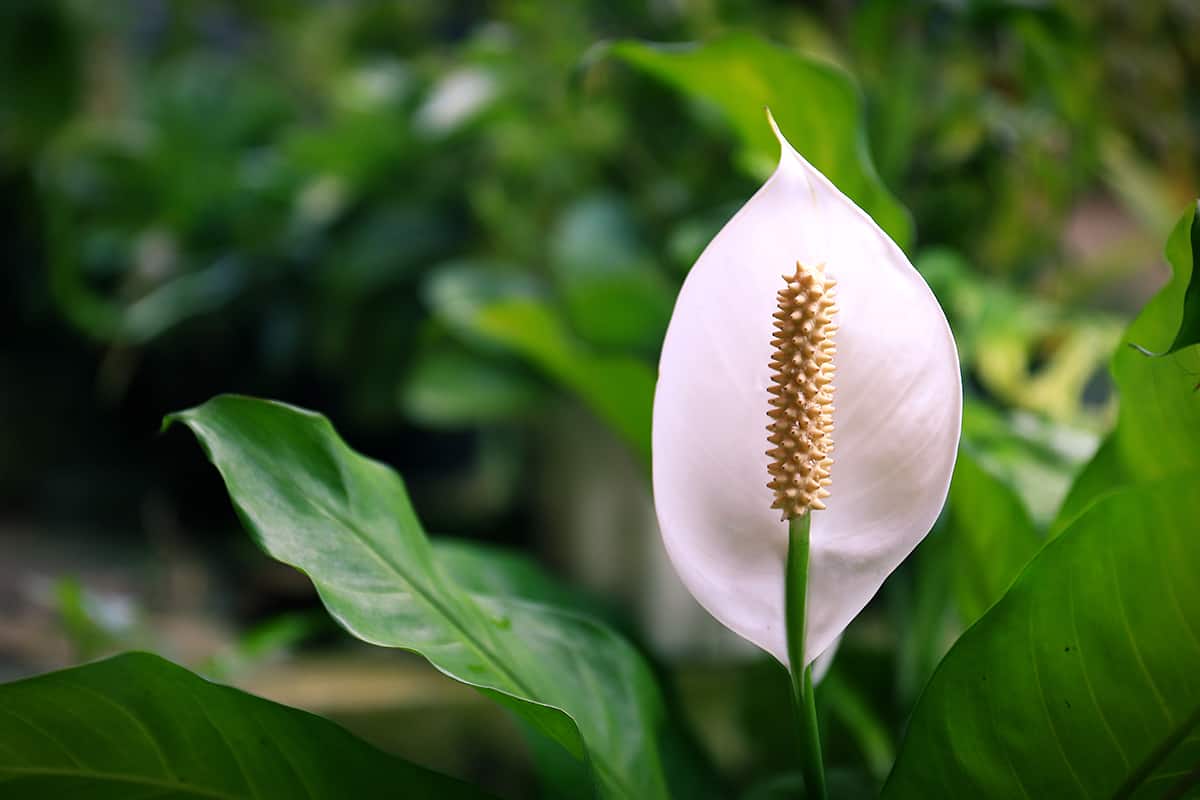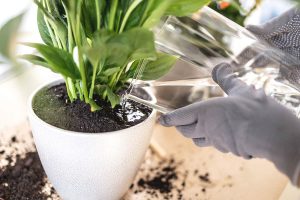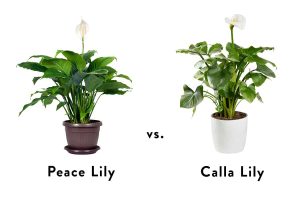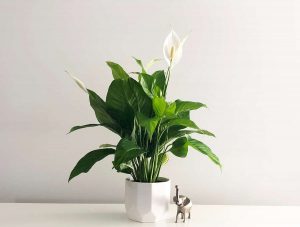Like all flowers, the blooms of a Peace Lily develop in stages. It is helpful to understand the progression of these stages so that you can spot any potential issues with the plant as soon as they occur, and it can help to ensure you give the Peace Lily the best care.
Here we look at Peace Lily flowers in more detail and explain the various stages of Peace Lily flowering.
Table of Contents
Peace Lily Flower Anatomy

The flowers of a Peace Lily are much more complex than many people realize. Here we investigate the parts of a Peace Lily flower and their scientific names to give you a better understanding of how these plants work.
Spathe
The white hooded part of a Peace Lily flower that looks like a white petal is actually not a petal at all. It is actually a modified leaf, which has evolved to take on the role of protecting the spadix.
When a spathe first emerges, it will often be pale green in color and can look much like a regular leaf. It will unfurl in the same way as the Peace Lily leaves also unfurl, which hints at its origins as a type of leaf. As the spathe develops, it will become a shade of pure white or creamy ivory and takes on the look of an elegant flower.
Spadix
The spadix is the central part of a Peace Lily bloom, which takes the shape of a thin, elongated rod in an erect position. It appears to be emerging out from the spathe. It is the spadix that actually holds all of the true flowers on the Peace Lily.
Flowers
If you look carefully at the spadix, you will see it is made up of lots of small bumps which come to tiny points. It is these ‘bumps’ that are actually the true flowers of the plant. Unlike the spathe, the flowers are not showy and instead are quite insignificant in terms of looks. They can be bright yellow in color, pale yellow, cream, or even pale green.
Peace Lily Stages of Flowering
Budding

The first stage of flowering will see the buds emerge at the end of the stems on a Peace Lily. The bud takes the shape of a rolled-up leaf, which will gradually begin to unfurl as it develops. It is quite common for the budding stage to go unnoticed by plant owners because the buds look so similar to the arrival of new foliage.
This is because the buds are actually a type of modified leaf called a spathe, so it is not surprising that they share a lot of similarities with regular Peace Lily leaves. The bud can start out pale green when it first emerges, much like the true foliage on the plant, or it can be white right from the start.
Blooming

As the plant progresses to the blooming stage, the bud will unfurl to reveal an elegant spathe in a curved shape which comes to a point at the tip. The spathe will become white or ivory-colored, and it will surround the spadix, which emerges during flowering.
The spadix is framed by the spathe, which is tasked with protecting the tiny flowers covering the spadix. As the development of the blooms continues, the small bumps on the spadix will become more pronounced, opening up as an invitation to pollinators.
Pollination

If your Peace Lily is growing outside, then it is likely it will get pollinated by insects. Pollination occurs when pollen is transferred across the male and female parts of the flower, resulting in fertilization.
Indoor plants may also get pollinated if you have open windows, which allow insects to come inside and explore your house plants, or if you wish, you could hand pollinate your Peace Lily using an artist’s small paintbrush. Pollination is not necessary unless you want your plant to produce seeds, so if you have a Peace Lily houseplant that you don’t intend to propagate via seeds, then you don’t need to worry about this.
Seed Production

After successful pollination, the tiny flowers covering the spadix will develop into seeds. They will usually transform from a shade of yellow to brown or black and take on a more dry, crispy appearance. Once the seeds develop, the white spathe protecting the spadix no longer serves a purpose, and it will begin to change color or wilt.
If you do not wish to collect the seeds of the plant, then the best thing to do is cut off the blooms at this point in the life cycle of the Peace Lily.
This is because the plant is using vital energy for seed production, which could be redirected to more fruitful uses such as flower or leaf production. Use a sharp and clean tool to remove the flower from the plant, just below where the spathe joins the stem.
Demise
Once the seeds are fully developed, they will begin to pop off of the spadix. In its native habitat, the aim of the plant is to spread these seeds to ensure the future of the species. At this point, the spathe may have turned brown and will usually have wilted or become crunchy. It will look much like a dead leaf, which, technically, is what it is.
Why Isn’t My Peace Lily Flowering?
If your Peace Lily isn’t flowering, this could be due to a number of reasons.
Immaturity
Peace Lilies will bloom when they have reached a certain age. If your Peace Lily is young and hasn’t bloomed yet, you should wait a little longer for your plant to start flowering.
Low Light
Peace Lilies are known for tolerating low lighting levels, so they are often utilized as a shade plant to brighten up a dark corner of a room. However, these plants need a reasonable level of light to create energy which allows the plants to produce flowers. If your Peace Lily is kept in a low-lit spot and is not flowering, try moving it to a brighter location to encourage blooming.
Underwatering
Peace Lilies need to grow in soil that is moist but not wet. If you are letting the soil dry out too much between waterings, then the plant may simply not have enough access to the moisture required to develop properly, leading to a lack of flowers. Water the plant more thoroughly or more frequently to resolve this issue.
Overwatering
As Peace Lily plants are quite thirsty, it can be easy to mistakenly water them too much. Though they like to be kept in moist soil, the soil should not be waterlogged. An overwatered Peace Lily can suffer from root rot, preventing moisture and nutrients from being absorbed through the roots and resulting in an inability to produce blooms.
Additives in Water
Peace Lilies are sensitive to additives in their water, such as chlorine and fluoride. A build-up of these types of minerals in the soil can affect flowering, so try to use water free from additives when you water your plant, such as collected rainwater. Once a year, give your plant a thorough flush to help wash away additives that have settled in your soil.






